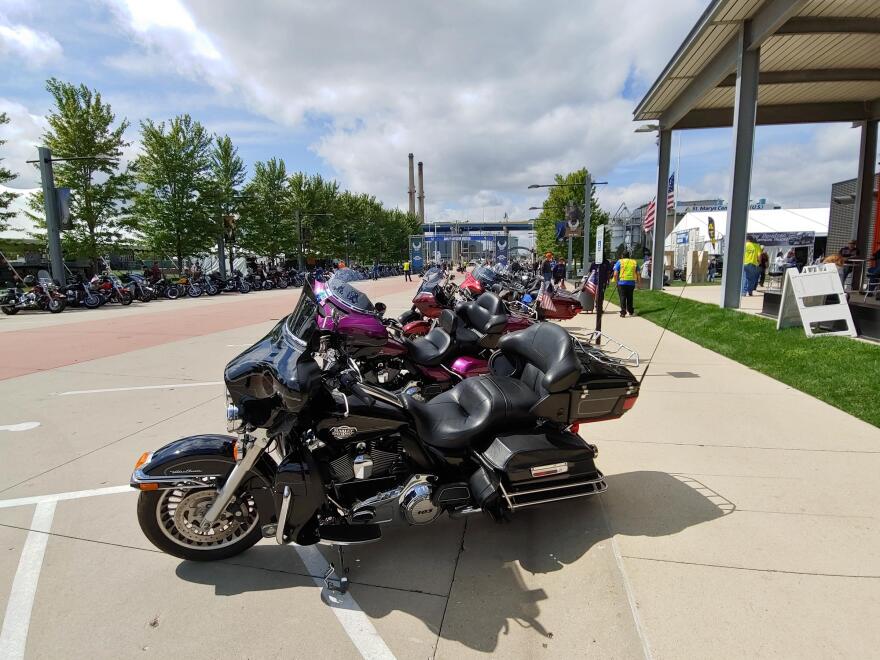Harley-Davidson is still a billion dollar company, and by far, sells more motorcycles in the U.S. than any other firm. It's been expanding its international sales. But earnings for the second quarter were down, the Kansas City plant is closing, and some financial analysts are wondering if Harley's heyday has passed.

Such talk seems to rev up Bill Davidson, great-grandson of of one the company's founders. Davidson heads the firm's local museum, and this week, summed up Harley's history of survival: "We've been crankin' motorcycles out our production doors continuously for 115 years. You know, we've been through a lot, thick and thin — Great Depression, World War One, World War Two, a buy-back, we never shut down production."
Davidson insists Harley has the look, sound and feel — what he calls "the DNA" — to continue to be successful.
Many of the Harley riders who have rumbled into Milwaukee for the company's 115th anniversary celebration seem willing to testify to that.
Outside the House of Harley-Davidson dealership in Greenfield, Mario Dellamico of Miami shows off his Ultra-Classic model. "I just enjoy the motorcycle. I enjoy riding. I like the brand, I like the way it looks and the way it sounds and the way it rides. The freedom. That's why I'm here," he says.
Dellamico is 49 years old, a bit younger than the Baby Boomers that have long formed Harley's core group of customers. But he's old enough to be able to afford a $27,000 motorcycle.

A 40-year-old, or Generation X, rider from Rockford, IL., Mark Zielinski, says he loves his less expensive Streetglide model. "With Vance & Hines Monster Pipes on it," he adds. "I'm slowly building it."
Zielinski says he used to ride another brand's hi-speed sport bike, or what some motorcyclists call a "crotch-rocket." He says he's not returning to those days, and thinks many other middle aged riders are also making the switch to more comfort.
"You know, the younger generation's catching on, and they're starting to see the crotch-rocket's not where it's at. You get off a crotch-rocket, you get off with a broken back. You get off a Harley and you go 'That was a good ride,' and keep on walkin'," Zielinski says, laughing.
But he says even a lower-priced Harley can be too expensive for many in the Millennial generation.
That's just one of Harley-Davidson challenges in attracting younger riders, as well as more women and more people of color, according to research analyst James Hardiman of Wedbush Securities. He adds the ''coolness factor" found in the days of movie stars Marlon Brando, Steve McQueen, Peter Fonda, and Dennis Hopper on a motorcycle has cooled.
"Motorcycles in the ... late '50s into the '60s and '70s were really cool. Not to say they're not cool today, but I don't think they represent quite what they used to," Hardiman says.
Harley-Davidson says it's trying to offer a rebirth of the cool at places like the company's Powertrain plant in Menonmonee Falls.

There, workers and robots put together the engines and transmissions that stoke some of the larger and mid-size motorcycles.
Plant General Manager Chuck Statz says the factory will eventually supply some of the upcoming models Harley publicized a month ago — generally lighter and sportier bikes — and the electric-powered motorcycle the company has been promising for a few years.
Statz says he's excited. "We know that electric vehicles will become a bigger part of what we do and we'll have to do. There are nations around the world making those changes, so we have to be ready for that."
Harley says it's spent a lot of money at its research facility — and time talking with customers about what they want — to improve the chances the innovations will pay off.
How many younger people will want the newer products is the key to Harley's future. But the company can take heart in knowing some younger riders have made their own way into the Harley family.

32-year-old Danny Holbus of Burlington bought a 1996 Harley Sportster a few years ago and has been converting it into a racing bike. He says he'll be taking part in a Harley-sponsored circle-track race at Bradford Beach this weekend.
"It's gonna be a beach race in the sand and I think a lot of people are going to see something really cool that you probably won't see very often," he expalins.
Holbus says the biggest concern he hears from other people his age is that motorcycling isn't safe.
It may be ironic then that Harley, in its attempt to broaden its appeal, says its Moto-Carnival along Lake Michigan will also offer high wire thrill shows and a rider inside a giant barrel, called the Wall of Death. But the company says there will be safety precautions.
Support is provided by Dr. Lawrence and Mrs. Hannah Goodman for Innovation reporting.




